Top Rankings
Moscow School District ranks among the top 20% of public school district in Idaho for:
Category
Attribute
Overall Rank
Highest overall rank (Top 20%)
Reading/Language Arts Proficiency
Highest reading/language arts proficiency (Top 20%)
Science Proficiency
Highest science proficiency (Top 20%)
Community Size
Largest student body (number of students) (Top 1%)
For the 2025 school year, there is 1 public preschool serving 321 students in Moscow School District. This district's average pre testing ranking is 10/10, which is in the top 10% of public pre schools in Idaho.
Public Preschool in Moscow School District have an average math proficiency score of 62% (versus the Idaho public pre school average of 47%), and reading proficiency score of 77% (versus the 53% statewide average).
Minority enrollment is 17% of the student body (majority Hispanic and Asian), which is less than the Idaho public preschool average of 28% (majority Hispanic).
Overview
This School District
This State (ID)
# Schools
8 Schools
327 Schools
# Students
2,333 Students
119,739 Students
# Teachers
159 Teachers
6,842 Teachers
Student : Teacher Ratio
15:1
15:1
District Rank
Moscow School District, which is ranked within the top 20% of all 172 school districts in Idaho (based off of combined math and reading proficiency testing data) for the 2021-2022 school year.
The school district's graduation rate of 80-84% has decreased from 83% over five school years.
Overall District Rank
#29 out of 173 school districts
(Top 20%)
(Top 20%)

Math Test Scores (% Proficient)
52%
42%
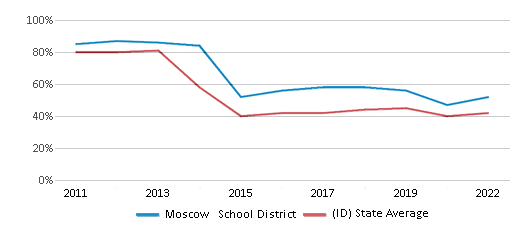
Reading/Language Arts Test Scores (% Proficient)
66%
55%
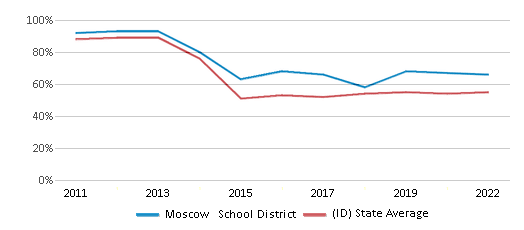
Science Test Scores (% Proficient)
58%
41%
Graduation Rate
80-84%
80%

Students by Ethnicity:
Diversity Score
0.30
0.44
# American Indian Students
24 Students
1,197 Students
% American Indian Students
1%
1%
# Asian Students
61 Students
1,310 Students
% Asian Students
3%
1%
# Hispanic Students
136 Students
24,515 Students
% Hispanic Students
6%
21%
# Black Students
37 Students
1,615 Students
% Black Students
2%
1%
# White Students
1,946 Students
86,517 Students
% White Students
83%
72%
# Hawaiian Students
12 Students
409 Students
% Hawaiian Students
n/a
n/a
# Two or more races Students
117 Students
4,176 Students
% of Two or more races Students
5%
4%
Students by Grade:
# Students in PK Grade:
23
4,101
# Students in K Grade:
128
15,927
# Students in 1st Grade:
179
17,353
# Students in 2nd Grade:
155
18,047
# Students in 3rd Grade:
157
17,683
# Students in 4th Grade:
157
17,263
# Students in 5th Grade:
174
16,475
# Students in 6th Grade:
178
6,296
# Students in 7th Grade:
188
1,739
# Students in 8th Grade:
160
1,592
# Students in 9th Grade:
234
899
# Students in 10th Grade:
205
834
# Students in 11th Grade:
184
808
# Students in 12th Grade:
211
722
# Ungraded Students:
-
-
District Revenue and Spending
The revenue/student of $13,463 is higher than the state median of $10,185. The school district revenue/student has stayed relatively flat over four school years.
The school district's spending/student of $12,608 is higher than the state median of $9,364. The school district spending/student has stayed relatively flat over four school years.
Total Revenue
$31 MM
$3,215 MM
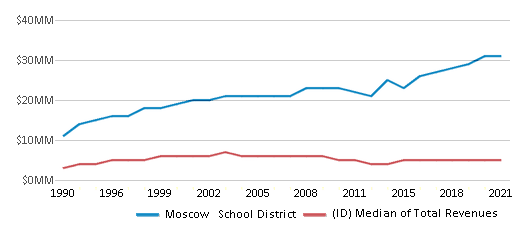
Spending
$29 MM
$2,956 MM
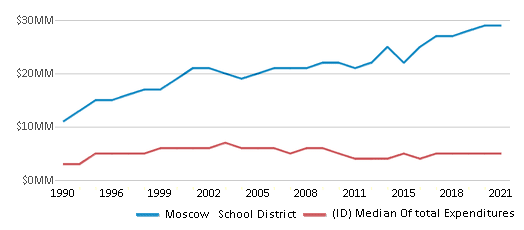
Revenue / Student
$13,463
$10,185
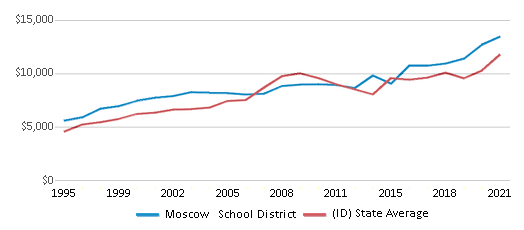
Spending / Student
$12,608
$9,364
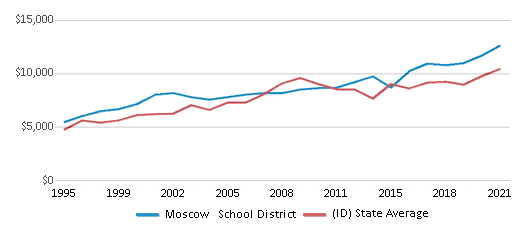
Best Moscow School District Public Preschools (2025)
School
(Math and Reading Proficiency)
(Math and Reading Proficiency)
Location
Grades
Students
Rank: #11.
A B Mcdonald Elementary School
(Math: 60-64% | Reading: 75-79%)
Rank:
Rank:
10/
Top 10%10
2323 East D Street
Moscow, ID 83843
(208) 882-0228
Moscow, ID 83843
(208) 882-0228
Grades: PK-5
| 321 students
Recent Articles

Year-Round Or Traditional Schedule?
Which is more appropriate for your child? A year-round attendance schedule or traditional schedule? We look at the pros and cons.

Why You Should Encourage Your Child to Join a Sports Team
Participating in team sports has a great many benefits for children, there is no doubt. In this article you will learn what those benefits are.

White Students are Now the Minority in U.S. Public Schools
Increasing birth rates among immigrant families from Asia and Central and South America, combined with lower birth rates among white families, means that for the first time in history, public school students in the United States are majority-minority. This shift in demographics poses difficulties for schools as they work to accommodate children of varying language abilities and socio-economic backgrounds.





